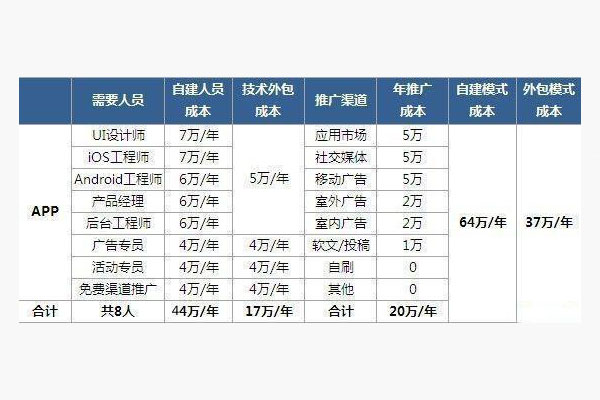自己开发一个app需要多少钱?
- 行业动态
- 2024-11-02
- 5
开发一个app的成本因项目复杂度、功能需求、设计要求等因素而异,从几千到几十万美元不等。
开发一个应用程序的成本可以根据多种因素而有很大的不同,包括应用的复杂性、功能需求、目标平台(iOS、Android或两者兼有)、设计要求以及开发团队的地理位置等,以下是一些影响成本的关键因素:
应用复杂度和功能需求
简单应用:比如一个基本的计算器或待办事项列表,可能只需要几千元人民币。
中等复杂度应用:如社交媒体应用或电子商务平台,可能需要数万元至数十万元人民币。
高度复杂的应用:如游戏或者具有高级功能的企业级应用,可能需要数十万元甚至更多的投资。
目标平台
单一平台:只针对iOS或Android开发通常会比跨平台开发便宜。
跨平台开发:使用如React Native, Flutter等框架可以同时为多个平台构建应用,但可能会增加初期的学习曲线和技术挑战。

设计和用户体验
自定义设计:独特的用户界面和用户体验设计需要额外的时间和资金。
模板设计:使用现成的设计模板可以节省成本,但可能牺牲一些个性化。
开发团队的地理位置
本地开发团队:通常成本较高,但沟通方便。
海外开发团队:可能提供更具竞争力的价格,但需要考虑语言和文化差异带来的沟通成本。

维护和更新
持续维护:应用发布后,还需要定期进行维护和更新,这也是一笔不小的开销。
以下是一个简化的成本估算表格示例:
| 项目 | 成本范围(人民币) |
| 市场调研 | 5,000 20,000 |
| 原型设计 | 10,000 50,000 |
| UI/UX设计 | 20,000 100,000 |
| 前端开发 | 50,000 300,000 |
| 后端开发 | 50,000 300,000 |
| 数据库管理 | 20,000 100,000 |
| 测试 | 20,000 50,000 |
| 部署和上线 | 10,000 50,000 |
| 营销和推广 | 可变,根据策略而定 |
| 总计 | 195,000 930,000+ |
这些数字仅供参考,实际成本会根据具体情况有所不同。
FAQs

Q1: 如何确定我的app开发预算?
A1: 确定预算时,首先明确你的应用需求和目标用户群体,考虑上述提到的各个因素,并咨询几家不同的开发公司获取报价,记得留出一部分预算用于不可预见的费用。
Q2: 我应该选择哪个平台进行开发?
A2: 这取决于你的目标市场和用户群体,如果你的用户主要使用iOS设备,那么优先开发iOS版本可能是明智的选择,如果目标是广泛的受众,那么跨平台开发可能是更好的选择,考虑使用跨平台开发工具来降低成本并加快上市时间。
















